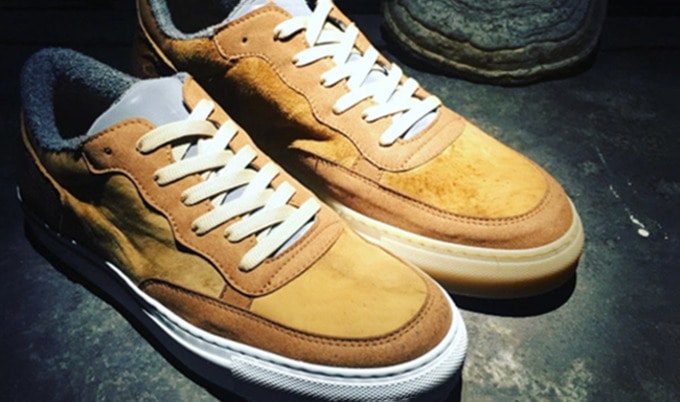
Mushroom textiles have a future in many industries. It can already be found in clothing and bags, and even durable furniture and building bricks. Mycelium are carbon-negative and can be naturally dyed any colour. Fabric created from mycelium is non-toxic, waterproof, and fire-resistant. It can be as thin as paper for dresses and lamp shades, or incredibly thick for heavy-duty items, and in both cases, the result is remarkably flexible and strong. With so much potential, is it any wonder that so many companies are now working to make this remarkable material part of our everyday life.
German engineering firm nat-2 created a vegan shoe made from a blend of fungi – concept and material for the Fungi Line was developed by German designer. The leather component of the shoe is made from a fungus that undergoes a natural, year-long harvest, after which it is used to make footwear, by hand in Italy. The balance of the shoe is made with a combination of eco-cotton terry cloth, microfiber suede from recycled bottles, cork, and rubber.
This alternative to animal leather, which the brand says has a “vintage look” and a soft texture is environmentally-friendly, organic, vegan, gluten-, and chemical-free. Its among a number of newly developed vegan alternatives to animal leather, including pineapple-based Piñatex, apple peel-based leather used by shoe brand VEERAH, and biotechnology startup Modern Meadow’s yeast-based leather that grows in a lab-setting.
Mushroom leather is an environmentally friendly material because it can be treated without using polluting substances. At the end of it’s life, the material is completely biodegradable and compostable. It is extremely light-weight and flexible too, which makes it effective for a wide range of products.
More sources:
https://materialdistrict.com/article/new-textile-grows-from-mushrooms
https://jonasedvard.dk/work/myx
https://materialdistrict.com/article/mushrooms-become-source-for-eco-building
One thought on “Organic / biodegradable shoes made of mushroom spores and plant fibers”
Comments are closed.

This is the reason for seeing multiple “Wars for Resources” – the horrors of Capitalism & Cronyism up live, keep reinventing the wheel forever!